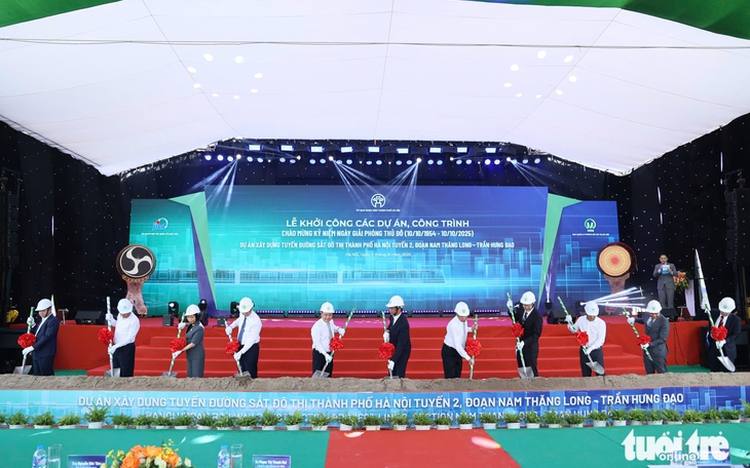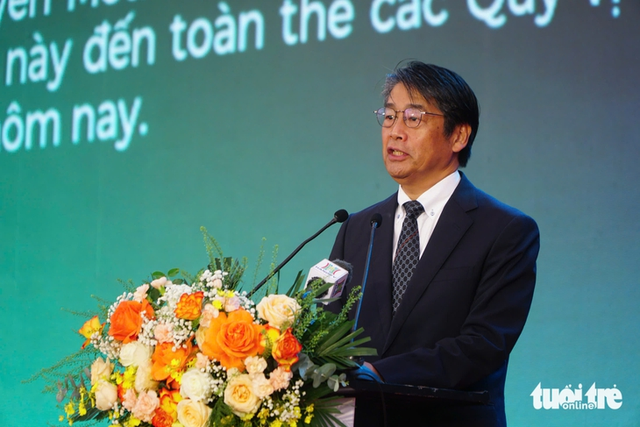
Delegates make a symbolic gesture to break ground on the second metro line project in Hanoi, October 9, 2025. Photo: Pham Tuan / Tuoi Tre
Strategic project for Hanoi
Speaking at the ceremony, Duong Duc Tuan, vice-chairman of the Hanoi People’s Committee, said the Nam Thang Long – Tran Hung Dao metro line has a total investment of VND35.679 trillion (US$1.4 billion).
It is funded by official development assistance (ODA) from the Japanese government and counterpart funding from the city’s budget.
This is a project of national importance and carries strategic significance for Hanoi’s development, Tuan said, requesting all departments, sectors, and local authorities to proactively and closely coordinate with the investor -- the Hanoi Metropolitan Railway Management Board -- during implementation.
He also asked the investor and contractors to maximize resources, manpower, and equipment to ensure that construction is carried out urgently, efficiently, and safely, in strict compliance with regulations and technical, aesthetic, and quality standards.
Efforts must be made to ensure traffic order, labor safety, environmental hygiene, and to adopt appropriate construction methods that minimize disruption to traffic flow.
As construction may impact local traffic, the Hanoi government called on residents and commuters to support and cooperate with construction units to accelerate progress and shorten the project timeline.
Symbol of Vietnam–Japan cooperation
Speaking at the event, Japanese Anbassador to Vietnam Ito Naoki emphasized that metro line No. 2 is a particularly important project, as it connects the rapidly developing Ciputra Urban Area, passes through the Starlake Urban Area and Ba Dinh – the nation’s political center – and ends at Hoan Kiem Lake, a spiritual symbol of Hanoi.

Ito Naoki, ambassador of Japan to Vietnam. Photo: Pham Tuan / Tuoi Tre
"I believe Hanoi’s metro line No. 2 will be widely used and become a symbol of cooperation between Japan and Vietnam," the diplomat said.
“Extending the line to Noi Bai International Airport is something many Vietnamese as well as tourists and entrepreneurs from around the world are looking forward to.
"Japan also hopes to collaborate with Vietnam on this future extension."
The metro line is scheduled to begin commercial operations in 2029, with two years allocated for training in operation and maintenance.
The project has a total length of 10.84 km, consisting of one at-grade station, two elevated stations, and seven underground stations.
It will run through seven wards: Xuan Dinh, Nghia Do, Ngoc Ha, Tay Ho, Ba Dinh, Hoan Kiem, and Cua Nam.
The line will operate with 10 trains, each comprising four cars.
Designed speeds reach up to 110 km/h on elevated sections and 80 km/h on underground sections, meeting modern technical standards while ensuring safety and environmental friendliness.
Hanoi also plans to develop the country’s first TOD (transit-oriented development) model at the Xuan Dinh Depot – a mixed-use hub integrating passenger transit, services, commerce, and housing.
At the underground C9 station, the line will connect with a planned square and park area on the eastern side of Hoan Kiem Lake, forming a TOD zone that links underground transport with public space, heritage preservation, and architectural highlights.


Max: 1500 characters
There are no comments yet. Be the first to comment.